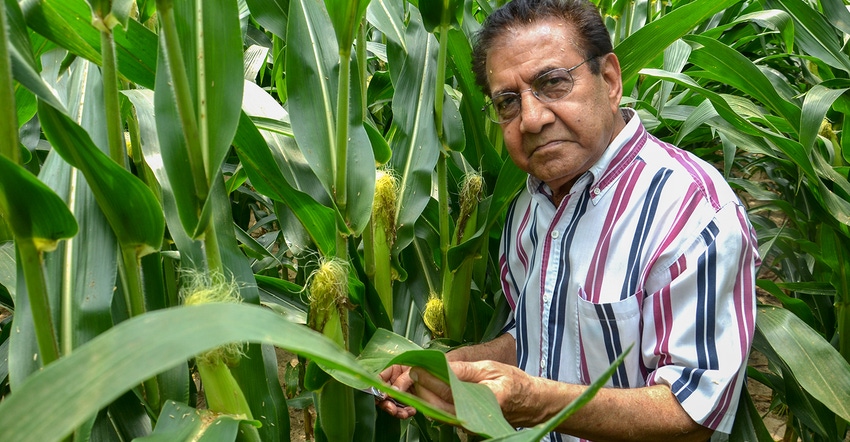
Here’s a two-question quiz that you should pass if you’re serious about producing top corn yields.
1. What is the biggest leaf in terms of leaf area on a typical corn plant?
2. What is the single most important leaf on the corn plant?
“If you said ‘ear leaf’ for both questions, you answered correctly,” says Dave Nanda, an independent crops consultant based in Indianapolis. “It’s typically the longest and widest leaf on a corn plant, and it’s a driver in collecting sunlight for photosynthesis. That’s the process by which plants produce sugars and starch which feed the plant and fill kernels on the ear.”
Size matters
Just from a physical science standpoint, ear leaves are important to corn plants because they have more leaf area available to collect sunlight than any other leaves, Nanda says. Leaves just above and below ear leaves are usually the next closest in size.
To prove his point Nanda pulled some leaves in a cornfield recently. He pulled ear leaves and leaves just above the ear. On every plant where he pulled leaves, the ear leaf was 2 to 4 inches longer and roughly a half-inch wider than the leaf directly above it.
Actual length and width may vary based on hybrid and weather conditions, Nanda notes. When he pulled ear leaves at the midpoint in the pollination process, they were roughly 34 to 35 inches long and 4.5 inches wide near the base that attaches to the stalk.
Leaves use this surface area to capture as much sunlight as possible, Nanda explains. Sunlight is a key driver in photosynthesis. Capturing more sunlight typically results in higher yields.
Disease angle
A common phrase you hear among agronomists talking about scouting for foliar diseases in corn is “your goal is to protect the ear leaf from disease lesions.” Once lesions reach the ear leaf or the leaves above the ear leaf, the situation becomes more critical.
“If disease gets established on these leaves and conditions favor disease, the disease can explode quickly,” Nanda says. If a significant amount of key leaf tissue is destroyed before grain fill is over, yield losses can result, he adds.
Various conditions are favorable to specific diseases. Gray leaf spot prefers warmer conditions, while northern corn leaf blight is typically more of a problem in summers that feature stretches of cool weather during the growing season. Southern rust also prefers warmer weather, with periods of wetness.
Southern rust took off in 2016, especially in southern Indiana, when warm, wet weather dominated at the end of August and early part of September. That allowed southern rust to spread quickly and cause considerable yield loss in some cases, even though most cornfields were past the stage where significant yield loss due to disease is normally an issue.
“The grain fill period is just critical,” Nanda says. “Keeping ear leaves and leaves above it green and healthy as long as possible is crucial.”
About the Author(s)
You May Also Like




